Configuring IPSec Between a Microsoft Windows 2000 Server and a Cisco Device
Available Languages
Contents
Introduction
This document demonstrates how to form an IPSec tunnel with pre-shared keys to join 2 private networks: a private network (192.168.l.X) inside a Cisco device and a private network (10.32.50.X) inside the Microsoft 2000 Server. We assume that traffic from inside the Cisco device and inside the 2000 Server to the Internet (represented here by the 172.18.124.X networks) is flowing prior to beginning this configuration.
You can find detailed information on configuring the Microsoft Windows 2000 server at the Microsoft web site: http://support.microsoft.com/support/kb/articles/Q252/7/35.ASP ![]()
Before You Begin
Conventions
For more information on document conventions, see the Cisco Technical Tips Conventions.
Prerequisites
There are no specific prerequisites for this document.
Components Used
These configurations were developed and tested using the software and hardware versions below.
-
Microsoft Windows 2000 Server 5.00.2195
-
Cisco 3640 Router with Cisco IOS® Software release c3640-ik2o3s-mz.121-5.T.bin
-
Cisco Secure PIX Firewall with PIX Software Release 5.2.1
-
Cisco VPN 3000 Concentrator with VPN 3000 Concentrator Software Version 2.5.2.F
-
Cisco VPN 5000 Concentrator with VPN 5000 Concentrator Software Version 5.2.19
The information presented in this document was created from devices in a specific lab environment. All of the devices used in this document started with a cleared (default) configuration. If you are working in a live network, ensure that you understand the potential impact of any command before using it.
Network Diagram
This document uses the network setup shown in the diagram below.
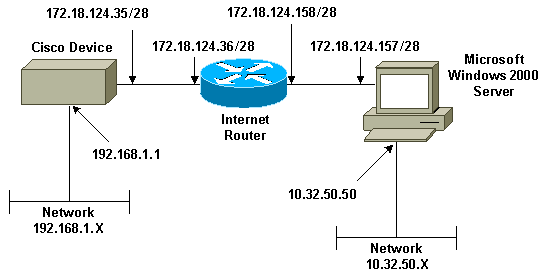
Configuring the Microsoft Windows 2000 Server to Work with Cisco Devices
Tasks Performed
This diagram shows the tasks performed in the Microsoft Windows 2000 server configuration:
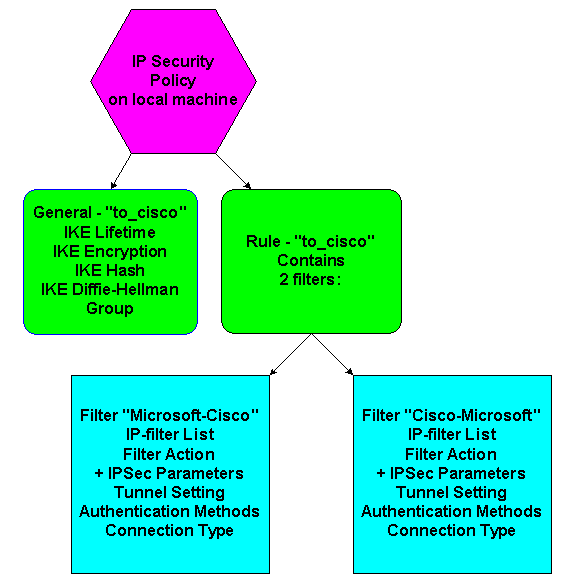
Step-by-Step Instructions
Once you have followed the configuration instructions ![]() on the Microsoft web site, use the following steps to verify that your configuration can work with Cisco devices. Comments and changes are noted with the screen captures.
on the Microsoft web site, use the following steps to verify that your configuration can work with Cisco devices. Comments and changes are noted with the screen captures.
-
Click Start > Run > secpol.msc on the Microsoft Windows 2000 Server, and verify the information on the following screens.
After the instructions on the Microsoft web site were used to configure a 2000 server, the following tunnel information was displayed.
Note: The example rule is called "to_cisco".
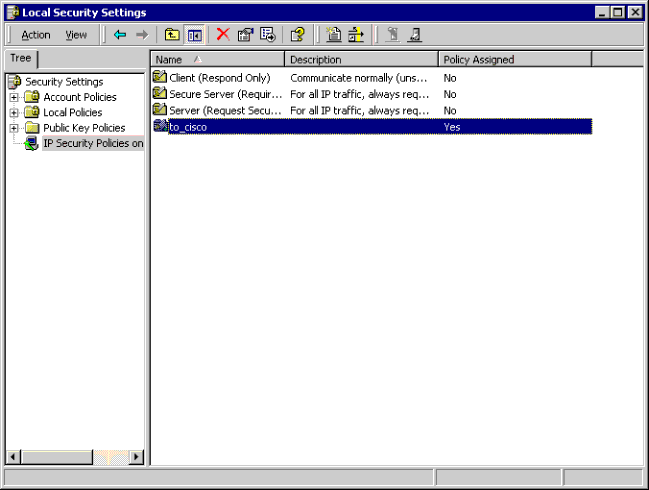
-
This example rule contains two filters: Microsoft-Cisco and Cisco-Microsoft.
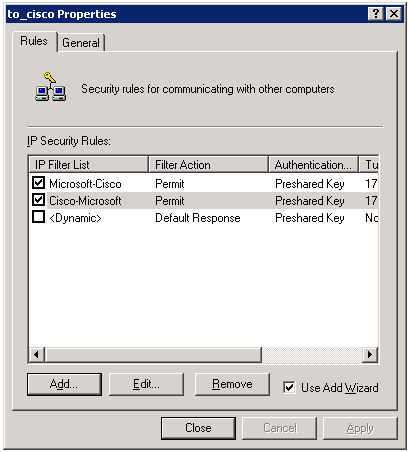
-
Select the Cisco-Microsoft IP Security Rule, then click Edit to view/add/edit the IP Filter Lists.
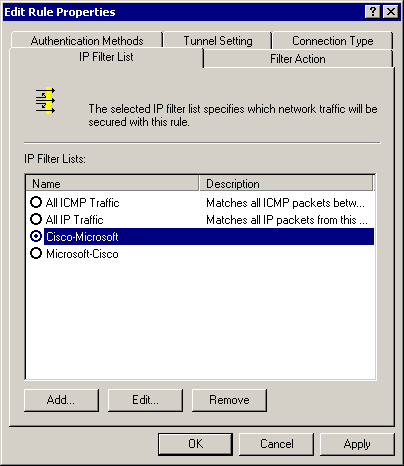
-
The rule's General > Advanced tab has the IKE lifetime (480 minutes = 28800 seconds):
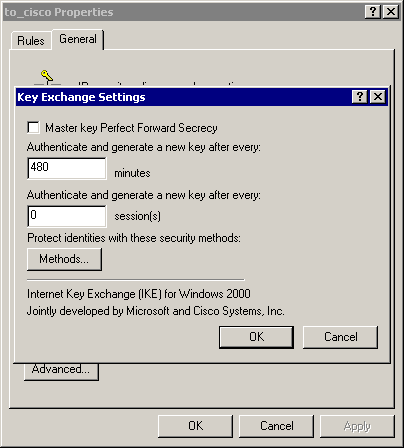
-
The rule's General > Advanced > Methods tab has the IKE encryption method (DES), IKE hashing (SHA1), and the Diffie-Helman group (Low(1)):
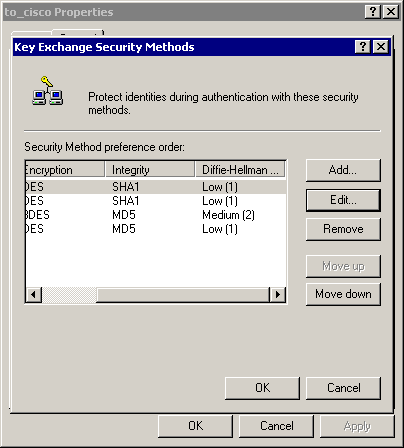
-
Each filter has 5 tabs:
-
Authentication Methods (Preshared keys for Internet Key Exchange [IKE]):
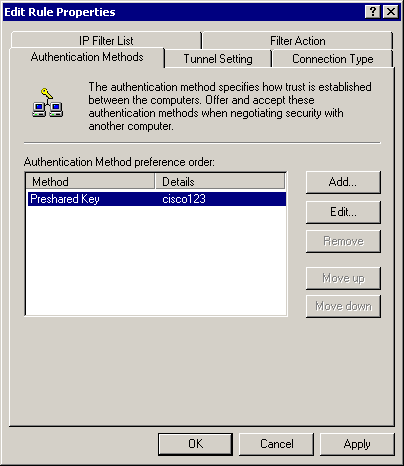
-
Connection Type (LAN):
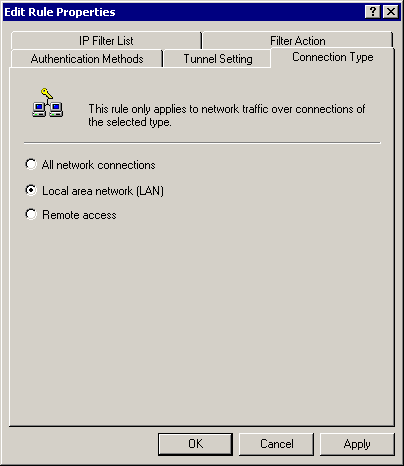
-
Filter Action (IPSec):
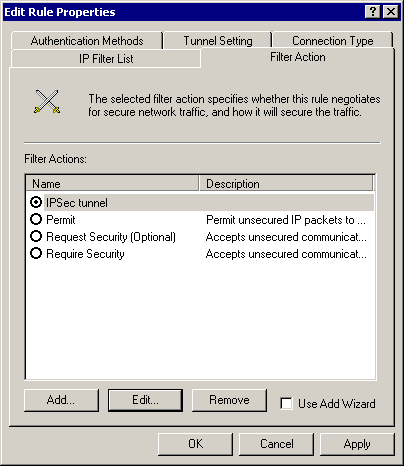
Select Filter Action > IPSec tunnel > Edit > Edit, and click Custom:
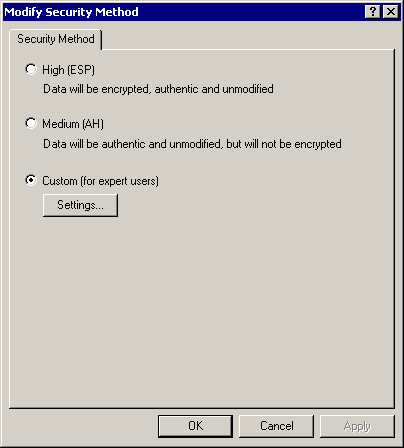
Click Settings - IPSec transforms and IPSec lifetime:
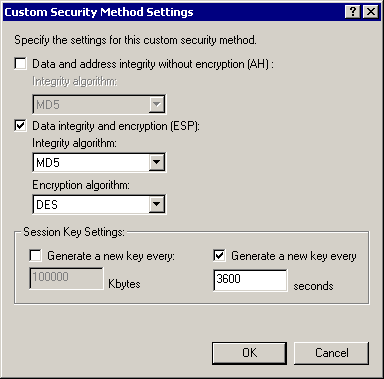
-
IP Filter List - source & destination networks to be encrypted:
For Cisco-Microsoft:
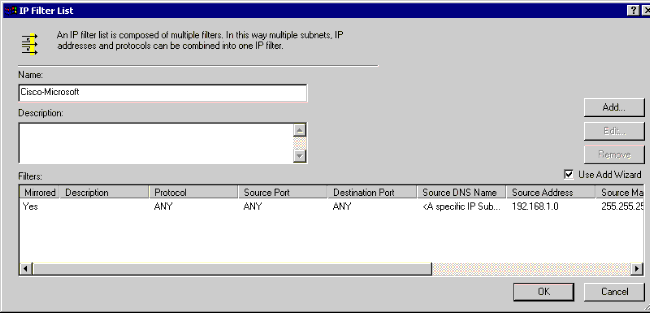
For Microsoft-Cisco:
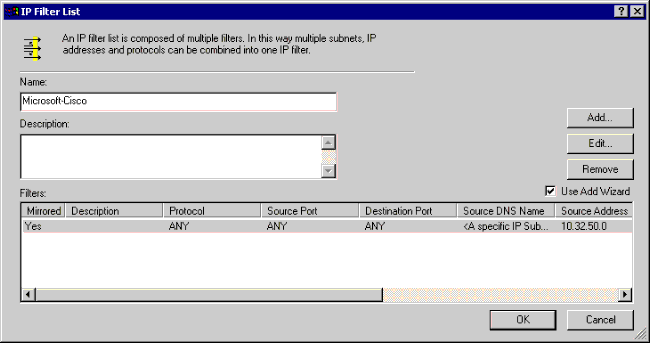
-
Tunnel Setting - encryption peers:
For Cisco-Microsoft:
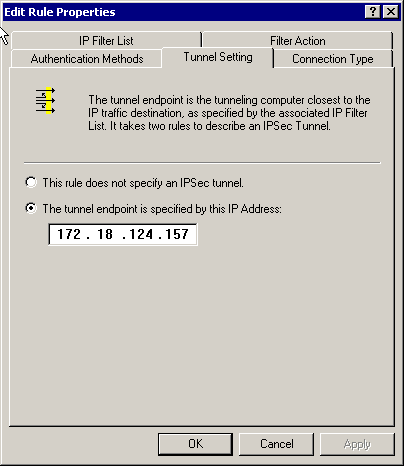
For Microsoft-Cisco:
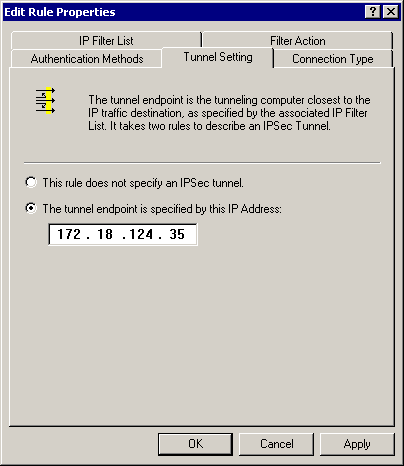
-
Configuring the Cisco Devices
Configure the Cisco router, PIX and VPN Concentrators as shown in the examples below.
Configuring the Cisco 3640 Router
| Cisco 3640 Router |
|---|
Current configuration : 1840 bytes ! version 12.1 no service single-slot-reload-enable service timestamps debug uptime service timestamps log uptime no service password-encryption ! hostname moss ! logging rate-limit console 10 except errors ! ip subnet-zero ! no ip finger ! ip audit notify log ip audit po max-events 100 ! crypto isakmp policy 1 !--- The following are IOS defaults so they do not appear: !--- IKE encryption method encryption des !--- IKE hashing hash sha !--- Diffie-Hellman group group 1 !--- Authentication method authentication pre-share !--- IKE lifetime lifetime 28800 !--- encryption peer crypto isakmp key cisco123 address 172.18.124.157 ! !--- The following is the IOS default so it does not appear: !--- IPSec lifetime crypto ipsec security-association lifetime seconds 3600 ! !--- IPSec transforms crypto ipsec transform-set rtpset esp-des esp-md5-hmac ! crypto map rtp 1 ipsec-isakmp !--- Encryption peer set peer 172.18.124.157 set transform-set rtpset !--- Source/Destination networks defined match address 115 ! call rsvp-sync ! interface Ethernet0/0 ip address 192.168.1.1 255.255.255.0 ip nat inside half-duplex ! interface Ethernet0/1 ip address 172.18.124.35 255.255.255.240 ip nat outside half-duplex crypto map rtp ! ip nat pool INTERNET 172.18.124.35 172.18.124.35 netmask 255.255.255.240 ip nat inside source route-map nonat pool INTERNET ip classless ip route 0.0.0.0 0.0.0.0 172.18.124.36 no ip http server ! access-list 101 deny ip 192.168.1.0 0.0.0.255 10.32.50.0 0.0.0.255 access-list 101 permit ip 192.168.1.0 0.0.0.255 any !--- Source/Destination networks defined access-list 115 permit ip 192.168.1.0 0.0.0.255 10.32.50.0 0.0.0.255 access-list 115 deny ip 192.168.1.0 0.0.0.255 any route-map nonat permit 10 match ip address 101 ! line con 0 transport input none line 65 94 line aux 0 line vty 0 4 ! end |
Configuring PIX
| PIX |
|---|
PIX Version 5.2(1) nameif ethernet0 outside security0 nameif ethernet1 inside security100 enable password 8Ry2YjIyt7RRXU24 encrypted passwd 2KFQnbNIdI.2KYOU encrypted hostname pixfirewall fixup protocol ftp 21 fixup protocol http 80 fixup protocol h323 1720 fixup protocol rsh 514 fixup protocol smtp 25 fixup protocol sqlnet 1521 fixup protocol sip 5060 names !--- Source/Destination networks defined access-list 115 permit ip 192.168.1.0 255.255.255.0 10.32.50.0 255.255.255.0 access-list 115 deny ip 192.168.1.0 255.255.255.0 any pager lines 24 logging on no logging timestamp no logging standby no logging console no logging monitor no logging buffered no logging trap no logging history logging facility 20 logging queue 512 interface ethernet0 auto interface ethernet1 10baset mtu outside 1500 mtu inside 1500 ip address outside 172.18.124.35 255.255.255.240 ip address inside 192.168.1.1 255.255.255.0 ip audit info action alarm ip audit attack action alarm no failover failover timeout 0:00:00 failover poll 15 failover ip address outside 0.0.0.0 failover ip address inside 0.0.0.0 arp timeout 14400 !--- Except Source/Destination from Network Address Translation (NAT): nat (inside) 0 access-list 115 route outside 0.0.0.0 0.0.0.0 172.18.124.36 1 timeout xlate 3:00:00 timeout conn 1:00:00 half-closed 0:10:00 udp 0:02:00 rpc 0:10:00 h323 0:05:00 sip 0:30:00 sip_media 0:02:00 timeout uauth 0:05:00 absolute aaa-server TACACS+ protocol tacacs+ aaa-server RADIUS protocol radius no snmp-server location no snmp-server contact snmp-server community public no snmp-server enable traps floodguard enable sysopt connection permit-ipsec no sysopt route dnat !--- IPSec transforms crypto ipsec transform-set myset esp-des esp-md5-hmac !--- IPSec lifetime crypto ipsec security-association lifetime seconds 3600 crypto map rtpmap 10 ipsec-isakmp !--- Source/Destination networks crypto map rtpmap 10 match address 115 !--- Encryption peer crypto map rtpmap 10 set peer 172.18.124.157 crypto map rtpmap 10 set transform-set myset crypto map rtpmap interface outside isakmp enable outside !--- Encryption peer isakmp key ******** address 172.18.124.157 netmask 255.255.255.240 isakmp identity address !--- Authentication method isakmp policy 10 authentication pre-share !--- IKE encryption method isakmp policy 10 encryption des !--- IKE hashing isakmp policy 10 hash sha !--- Diffie-Hellman group isakmp policy 10 group 1 !--- IKE lifetime isakmp policy 10 lifetime 28800 telnet timeout 5 ssh timeout 5 terminal width 80 Cryptochecksum:c237ed11307abea7b530bbd0c2b2ec08 : end |
Configuring the VPN 3000 Concentrator
Use the menu options and parameters shown below to configure the VPN Concentrator as needed.
-
To add an IKE proposal, select Configuration > System > Tunneling Protocols > IPSec > IKE Proposals > Add a proposal.
Proposal Name = DES-SHA !--- Authentication method Authentication Mode = Preshared Keys !--- IKE hashing Authentication Algorithm = SHA/HMAC-160 !--- IKE encryption method Encryption Algorithm = DES-56 !--- Diffie-Hellman group Diffie Hellman Group = Group 1 (768-bits) Lifetime Measurement = Time Date Lifetime = 10000 !--- IKE lifetime Time Lifetime = 28800
-
To define the LAN-to-LAN tunnel, select Configuration > System > Tunneling Protocols > IPSec LAN-to-LAN.
Name = to_2000 Interface = Ethernet 2 (Public) 172.18.124.35/28 !--- Encryption peer Peer = 172.18.124.157 !--- Authentication method Digital Certs = none (Use Pre-shared Keys) Pre-shared key = cisco123 !--- IPSec transforms Authentication = ESP/MD5/HMAC-128 Encryption = DES-56 !--- Use the IKE proposal IKE Proposal = DES-SHA Autodiscovery = off !--- Source network defined Local Network Network List = Use IP Address/Wildcard-mask below IP Address 192.168.1.0 Wildcard Mask = 0.0.0.255 !--- Destination network defined Remote Network Network List = Use IP Address/Wildcard-mask below IP Address 10.32.50.0 Wildcard Mask 0.0.0.255
-
To modify the security association, select Configuration > Policy Management > Traffic Management > Security Associations > Modify.
SA Name = L2L-to_2000 Inheritance = From Rule IPSec Parameters !--- IPSec transforms Authentication Algorithm = ESP/MD5/HMAC-128 Encryption Algorithm = DES-56 Encapsulation Mode = Tunnel PFS = Disabled Lifetime Measurement = Time Data Lifetime = 10000 !--- IPSec lifetime Time Lifetime = 3600 Ike Parameters !--- Encryption peer IKE Peer = 172.18.124.157 Negotiation Mode = Main !--- Authentication method Digital Certificate = None (Use Preshared Keys) !--- Use the IKE proposal IKE Proposal DES-SHA
Configuring the VPN 5000 Concentrator
| VPN 5000 Concentrator |
|---|
[ IP Ethernet 1:0 ] Mode = Routed SubnetMask = 255.255.255.240 IPAddress = 172.18.124.35 [ General ] IPSecGateway = 172.18.124.36 DeviceName = "cisco" EthernetAddress = 00:00:a5:f0:c8:00 DeviceType = VPN 5002/8 Concentrator ConfiguredOn = Timeserver not configured ConfiguredFrom = Command Line, from Console [ IP Ethernet 0:0 ] Mode = Routed SubnetMask = 255.255.255.0 IPAddress = 192.168.1.1 [ Tunnel Partner VPN 1 ] !--- Encryption peer Partner = 172.18.124.157 !--- IPSec lifetime KeyLifeSecs = 3600 BindTo = "ethernet 1:0" !--- Authentication method SharedKey = "cisco123" KeyManage = Auto !--- IPSec transforms Transform = esp(md5,des) Mode = Main !--- Destination network defined Peer = "10.32.50.0/24" !--- Source network defined LocalAccess = "192.168.1.0/24" [ IP Static ] 10.32.50.0 255.255.255.0 VPN 1 1 [ IP VPN 1 ] Mode = Routed Numbered = Off [ IKE Policy ] !--- IKE hashing, encryption, Diffie-Hellman group Protection = SHA_DES_G1 Configuration size is 1088 out of 65500 bytes. |
Verify
There is currently no verification procedure available for this configuration.
Troubleshoot
This section provides information you can use to troubleshoot your configurations.
Troubleshooting Commands
Certain show commands are supported by the Output Interpreter Tool (registered customers only) , which allows you to view an analysis of show command output.
Note: Before issuing debug commands, please see Important Information on Debug Commands.
Cisco 3640 Router
-
debug crypto engine - Shows debug messages about crypto engines, which perform encryption and decryption.
-
debug crypto isakmp - Shows messages about IKE events.
-
debug crypto ipsec - Shows IPSec events.
-
show crypto isakmp sa - Shows all current IKE security associations (SAs) at a peer.
-
show crypto ipsec sa - Shows the settings used by current security associations.
-
clear crypto isakmp - (from configuration mode) Clears all active IKE connections.
-
clear crypto sa - (from configuration mode) Deletes all IPSec security associations.
PIX
-
debug crypto ipsec - Shows the IPSec negotiations of phase 2.
-
debug crypto isakmp - Shows the Internet Security Association and Key Management Protocol (ISAKMP) negotiations of phase 1.
-
debug crypto engine - Shows the traffic that is encrypted.
-
show crypto ipsec sa - Shows the phase 2 security associations.
-
show crypto isakmp sa - Shows the phase 1 security associations.
-
clear crypto isakmp - (from configuration mode) Clears Internet Key Exchange (IKE) security associations.
-
clear crypto ipsec sa - (from configuration mode) Clears IPSec security associations.
VPN 3000 Concentrator
-
- Start the VPN 3000 Concentrator debug by selecting Configuration > System > Events > Classes > Modify (Severity to Log=1-13, Severity to Console=1-3): IKE, IKEDBG, IKEDECODE, IPSEC, IPSECDBG, IPSECDECODE
-
- The event log can be cleared or retrieved by selecting Monitoring > Event Log.
-
- The LAN-to-LAN tunnel traffic can be monitored in Monitoring > Sessions.
-
- The tunnel can be cleared in Administration > Administer Sessions > LAN-to-LAN sessions > Actions - Logout.
VPN 5000 Concentrator
-
vpn trace dump all - Shows information about all matching VPN connections, including information about the time, the VPN number, the real IP address of the peer, which scripts have been run, and in the case of an error, the routine and line number of the software code where the error occurred.
-
show vpn statistics - Shows the following information for Users, Partners, and the Total for both. (For modular models, the display includes a section for each module slot.) Current Active - The current active connections. In Negot - The currently negotiating connections. High Water - The highest number of concurrent active connections since the last reboot. Running Total - The total number of successful connections since the last reboot. Tunnel Starts - The number of tunnel starts. Tunnel OK - The number of tunnels for which there were no errors. Tunnel Error - The number of tunnels with errors.
-
show vpn statistics verbose - Shows ISAKMP negotiation statistics, and many more active connection statistics.
Related Information
Revision History
| Revision | Publish Date | Comments |
|---|---|---|
1.0 |
04-Apr-2008 |
Initial Release |
Contact Cisco
- Open a Support Case

- (Requires a Cisco Service Contract)














 Feedback
Feedback